Mechanical processing techniques of precious metals for various applications
Heraeus
As well as being highly important as investments, commodities and in jewellery, precious metals and their alloys are highly valued materials for high-performance applications. These applications range from chemical, pharmaceutical and medical device industries through to electronics, renewable energy and automotive.
Precious metals include gold, silver and the platinum group metals, or PGMs. The PGMs consist of platinum, palladium, ruthenium, rhodium, osmium and iridium. Alloys of these metals are particularly useful in applications where high electrical conductivity, resistance to high temperatures, oxidation resistance and good mechanical properties are required.
Precious metal products are generally manufactured via melting followed by mechanical processing.
Mechanical processing techniques for precious metals
The mechanical techniques employed for processing precious metals are similar to that of other metals and are divided into casting, forming, cutting and joining.
Casting
Casting is the process of introducing molten metal into a mould and allowing the metal to cool and solidify in order to take the shape of the mould. The various types of casting process include
- Investment casting (also known as lost wax casting)
- Centrifugal casting
- Die casting
- Sand casting
- Spin casting
Casting is usually used to produce ingots or shapes. Ingots are simple shapes indented for further processing, whereas shapes are generally more complex geometries requiring little further processing.
Melting PGMs
PGMs and PGM alloys typically have high melting temperatures and are difficult to melt. For that reason, high-frequency induction heating is often used for melting, as well as electron beam heating and arc melting.
Induction heating is the quickest and most effective method for larger quantities of PGMs (greater than 1 kg). For PGMs with higher melting temperatures, arc welding is used for smaller amounts (less than 1 kg) and electron beam melting for larger quantities.
The effect of casting on precious metal properties
When casting precious metals, there are some defects which can arise that are important to look out for.
1. Porosity
The appearance of pores is the most common defect that can appear when casting. Types of porosity defect include gas porosity, shrinkage porosity, inclusion porosity and oxide inclusion porosity.
- In the case of gas porosity, pores appear as spherical holes resembling pinholes on the polished surface of the casting and cannot be removed via polishing. It is caused by an excessively high casting temperature, causing the investment powder to decompose, producing gas that enters the molten metal. It can also be caused by the use of too much recycled or contaminated material.
- Shrinkage porosity appears in the form of very small pores with a dendritic structure. This can be caused by an incorrect sprue position or a low casting temperature. Ideally, the sprue should be placed at the thickest part of the cast.
- Inclusion porosity appears as randomly distributed irregular pores. Under magnification, no dendritic structure is apparent. This kind of porosity is caused by overuse of flux for cleaning and from the recycling of used wax, which can contain residual investment fragments.
- Oxide inclusion porosity appears after polishing with a characteristic ‘crows feet’ shape and is similar to shrinkage porosity. This is caused by oxidation of alloys with high zinc content or by overuse of recycled or contaminated material.
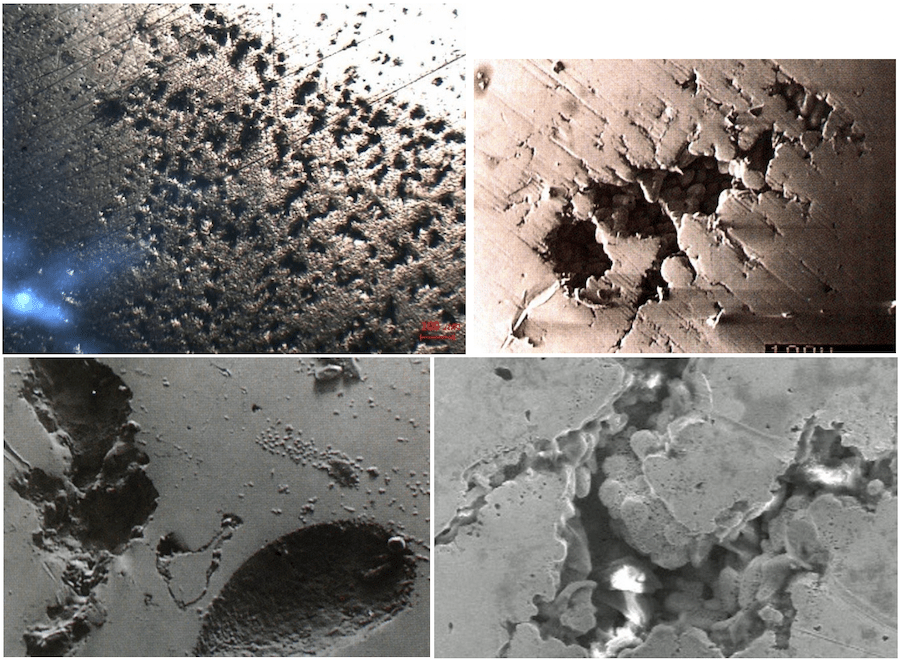
Figure 1. Examples of porosity defects in precious metals. Upper left: gas porosity, upper right: shrinkage porosity, lower left: inclusion porosity, lower right: oxide inclusion porosity. Credit: Heraeus.
2. Hard spots
Another defect which can appear in the casting process is the appearance of hard spots. These are inclusions that have a higher hardness than the surrounding metal and usually become visible during the polishing stage. Hard spots can be very difficult to repair.
- In white gold, hard spots can be caused by oxidation of nickel, the presence of silicon, or contaminated material.
- In gold, hard spots can be caused by the presence of PGMs.
- Hard spots can also be caused by an excessive amount of grain refiner.
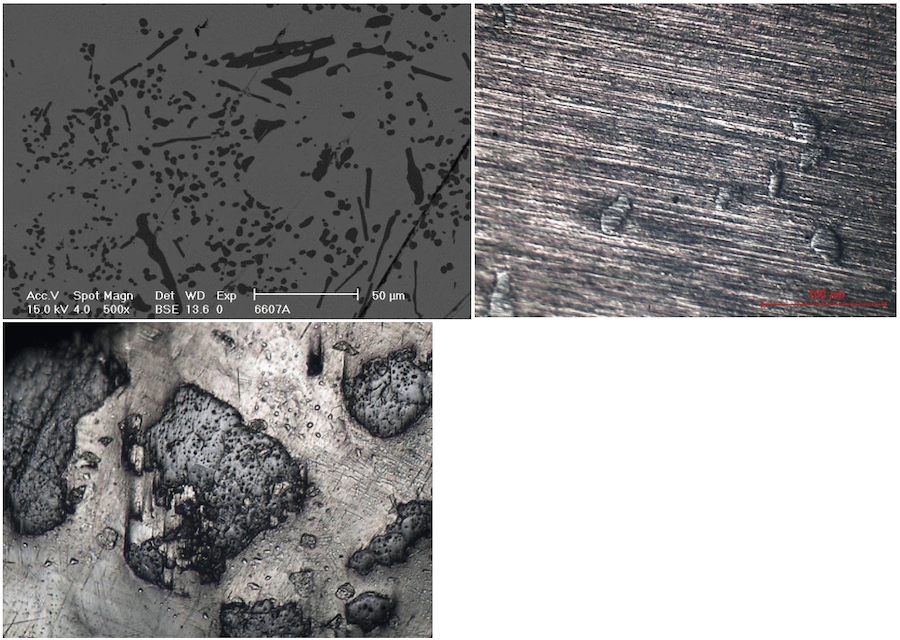
Figure 2. Examples of hard spots in precious metals. Upper left: hard spots in white gold, upper right: hard spots caused by grain refiners, bottom: hard spots caused by contaminated gold. Credit: Heraeus.
3. Rough surface
Improper casting can also result in excessive surface roughness.
- A dendritic surface appears when the casting temperature is too high, causing the mould to decompose (in the case of investment casting) or when there is improper use of forming gas.
- A sandy surface can appear with some fins at the edge of the surface. This often appears with heavier alloys such as 18K-white gold or platinum. This is due to a weak or low-quality investment mould.
- A water mark appears as raised traces. This is due to excessive water in the investment slurry.
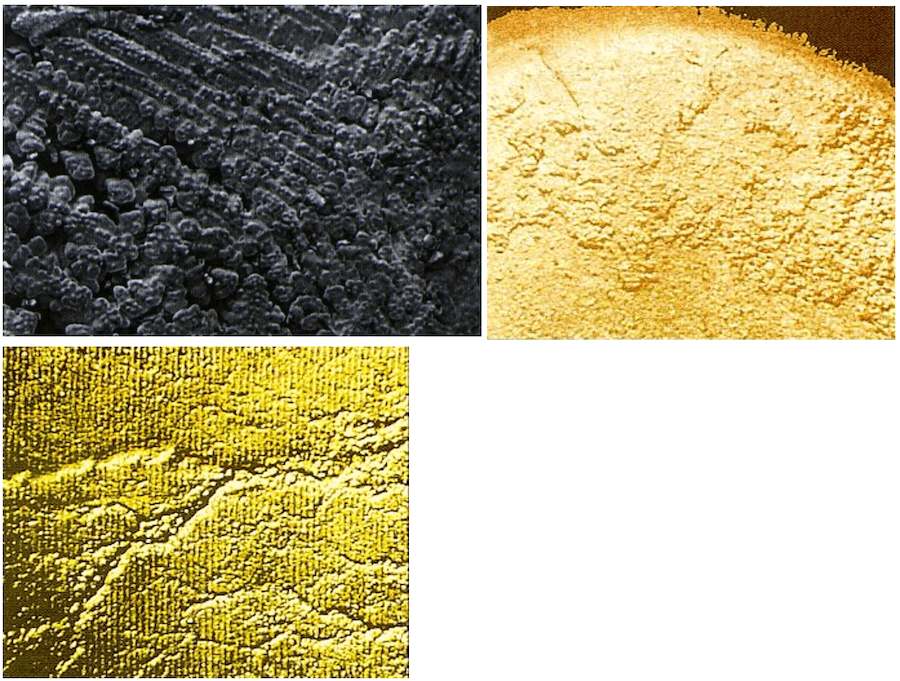
Figure 3. Examples of rough surface defects in precious metals. Upper left: dendritic surface, Upper right: sandy surface, Bottom: water mark. Credit: Heraeus.
4. Cracking
Cracking is another defect which can occur in the process of casting precious metals. Cracks appear most commonly during the de-investing process.
- Cracks can be caused by the presence of excessive silicon in the alloy.
- For 18K red gold or gold with high copper content, cracks appear when the alloy is quenched too slowly in water. This can be resolved via quicker quenching or reduced copper content.
- Cracks can appear from the presence of impurities, which are often the result of oxidation of the metals during melting. This can be caused by the presence of too much scrap in the melt. In the case of gold, non-oxide metal impurities are often lead, bismuth or antimony.
- Cracks from shrinkage can occur from improper sprue design or a low casting temperature.
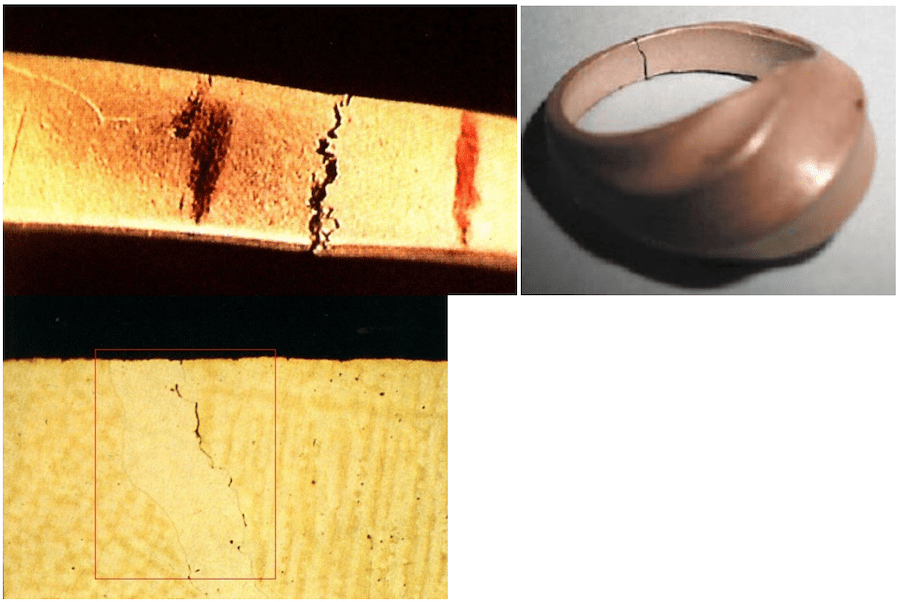
Figure 4. Examples of cracking in precious metals. Upper left: cracking caused by silicon, upper right: cracking in red gold, bottom: cracking caused by impurity inclusions. Credit: Heraeus.
5. Discolouration
Discolouration of precious metals is particularly troublesome in jewellery making.
- Red stain or fire stain occurs as red or dark patches when processing sterling silver and cannot be removed, even with excessive polishing. This is caused by oxidation of the alloys during the casting process, particularly of copper. It can be prevented by limiting the use of recycled materials and the use of a protective gas such as nitrogen or argon.
- Tarnishing is the discolouration of the metal after exposure to air for a certain time. This is due to the formation of silver or copper sulphide. It can be combated by coating the piece after casting or using anti-tarnishing agents in the materials.
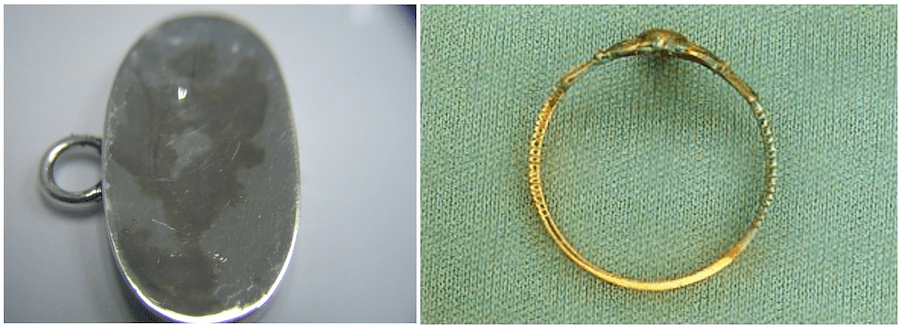
Figure 5. Examples of discolouration in precious metals. Left: red stain or fire stain, right: tarnishing. Credit: Heraeus.
Forming
Forming of precious metals is the process of using plastic deformation to reshape the object and is often done in the presence of heat. In forming processes, no material is added or removed, in contrast to cutting. Some common forming processes include:
- Forging, shaping of the metal by compressive forces.
- Rolling, passing the metal through rollers in order to reduce or even the thickness.
- Drawing, using tensile forces to stretch the metal
- Stamping, or die forming, where the metal is forced to take the shape of a die via a stamp
- Sintering, compressing metal grains together using heat and/or pressure in order to form a single solid
The effects of forming on precious metal properties
Most forging processes, when performed cold, increase the strength of the metal via the modification of the metal microstructure. This is known as work hardening. When the forging processes are performed at elevated temperatures, the work hardening is limited.
Forming can induce defects in precious metals, depending on the forming process.
- Forging defects can include surface or internal cracks when the material temperature is too low.
- Rolling defects include wavy edges as a result of an uneven roll, surface cracks in materials with low ductility, or alligatoring where the material splits due to defects in the original cast material.
- Drawing defects include wrinkling in the flange or wall due to compressive buckling. Tearing, earring and surface scratches can also occur.
- Stamping can result in surface defects, wrinkles, splits and springback.
Cutting
Cutting is a mechanical process used to shape metals by removing unwanted material. Many precious metals, and particularly their alloys, have high hardness and require cutting tools tipped with diamond or carbide.
The cutting processes used on precious metals include:
- Planing, used to create accurate, flat surfaces and slots by cutting with a linear motion.
- Turning, shaping the part on a lathe via rotation together with cutting in a linear motion.
- Swiss turning, a high-precision turning method for producing small, highly accurate parts. The Swiss screw machine has lower vibration than a traditional lathe.
- Drilling, used to create holes of a circular cross-section.
- Other cutting processes include milling, threading, grinding and filing.
For the harder precious metals and their alloys, the most significant effect during cutting and machining is the wear sustained by the cutting equipment, as opposed to the precious metal parts.
Joining
Common joining processes used for precious metals include:
- Welding, which can be performed by tungsten inert gas (TIG) welding.
- Laminating, used for electrical components
- Plating, for enhancing the electrical, mechanical, corrosion or aesthetic properties of a part.
- Cladding, often used for combining precious and non-precious metals.
The various joining processes enable further applications of precious metals by combining their high-performance properties with the properties of other materials.
Industry applications of precious metals
Thanks to their high-performance, such as excellent heat and corrosion resistance, high electrical conductivity and hardness, precious metals and their alloys are found in almost every industrial product. Some of the industries for which precious metals in most demand include
- Automotive industry and its suppliers
- Chemical and petrochemical industry
- Electronics industry
- Glass industry
- Pharmaceutical industry
- Fertilizer industry
- Jewellery industry
Sourcing precious metals for industry applications
For industrial applications, gold and silver typically come in granular form. Other precious metals, including the PGMs platinum, palladium, rhodium, ruthenium and iridium come in sponge or powder form. Sponge is a form of powder with multiple grain sizes.

Figure 6. Top: gold in granular form, bottom: PGM powder. Credit: Heraeus.
When it comes to sourcing precious metals, quality is of huge importance. Defects can play an important role in the performance of finished parts. Because of this, it’s important to choose a supplier of precious metals, which can deliver high purity. One of the leading precious metals suppliers today is Heraeus.
Heraeus provides precious comprehensive expertise in the precious metal loop – from trading to precious metal products to recycling. The product range varies from contact products, PGM-fabrications and semi-finished materials to high-tech materials and compounds. Their fields of application are sliding and switching contacts, spark plugs, bushings, glass tools, labware, wires and materials for probe needles as well as master alloys, TC-balls, pen points and irradiation sources.
If you’re interested in sourcing precious metals for your application, get in touch with Heraeus right here on Matmatch.
Article by Heraeus
A globally leading technology group, Heraeus is headquartered in Hanau, Germany. Founded in 1851, it is a family-owned portfolio company which traces its roots back to a pharmacy opened by the family in 1660. Today, Heraeus combines businesses in the environmental, energy, electronics, health, mobility and industrial applications sectors.
The Global Business Unit Heraeus Precious Metals is a leading provider of precious metal services and products. We combine all activities related to our comprehensive expertise in the precious metal loop – from trading to precious metal products to recycling.
The business line Functional Materials is an expert for mechanical processing of precious metals and their alloys. The product range varies from contact products, PGM-fabrications and semi-finished materials to high-tech materials and compounds. Their fields of application are sliding and switching contacts, spark plugs, bushings, glass tools, labware, wires and materials for probe needles as well as master alloys, TC-balls, pen points and irradiation sources.

